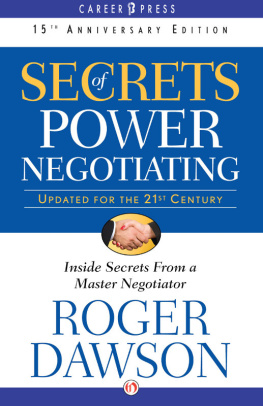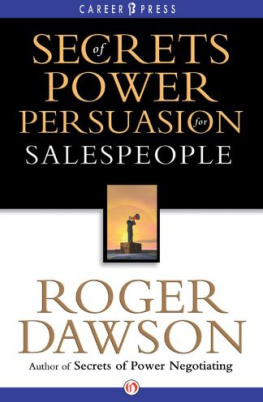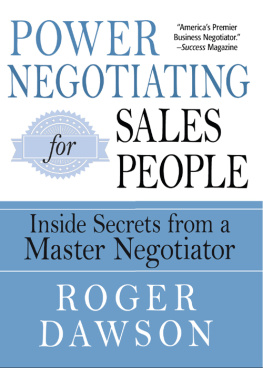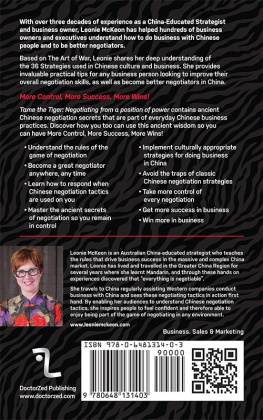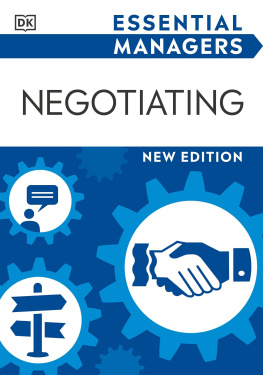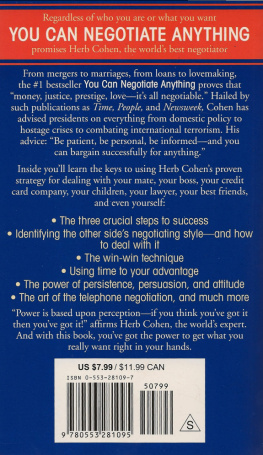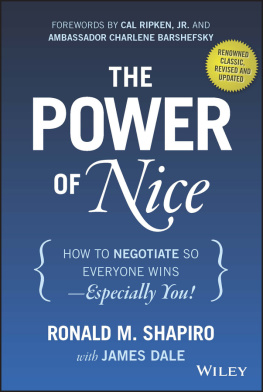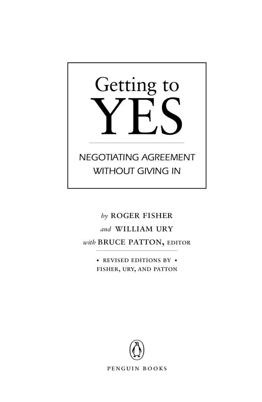
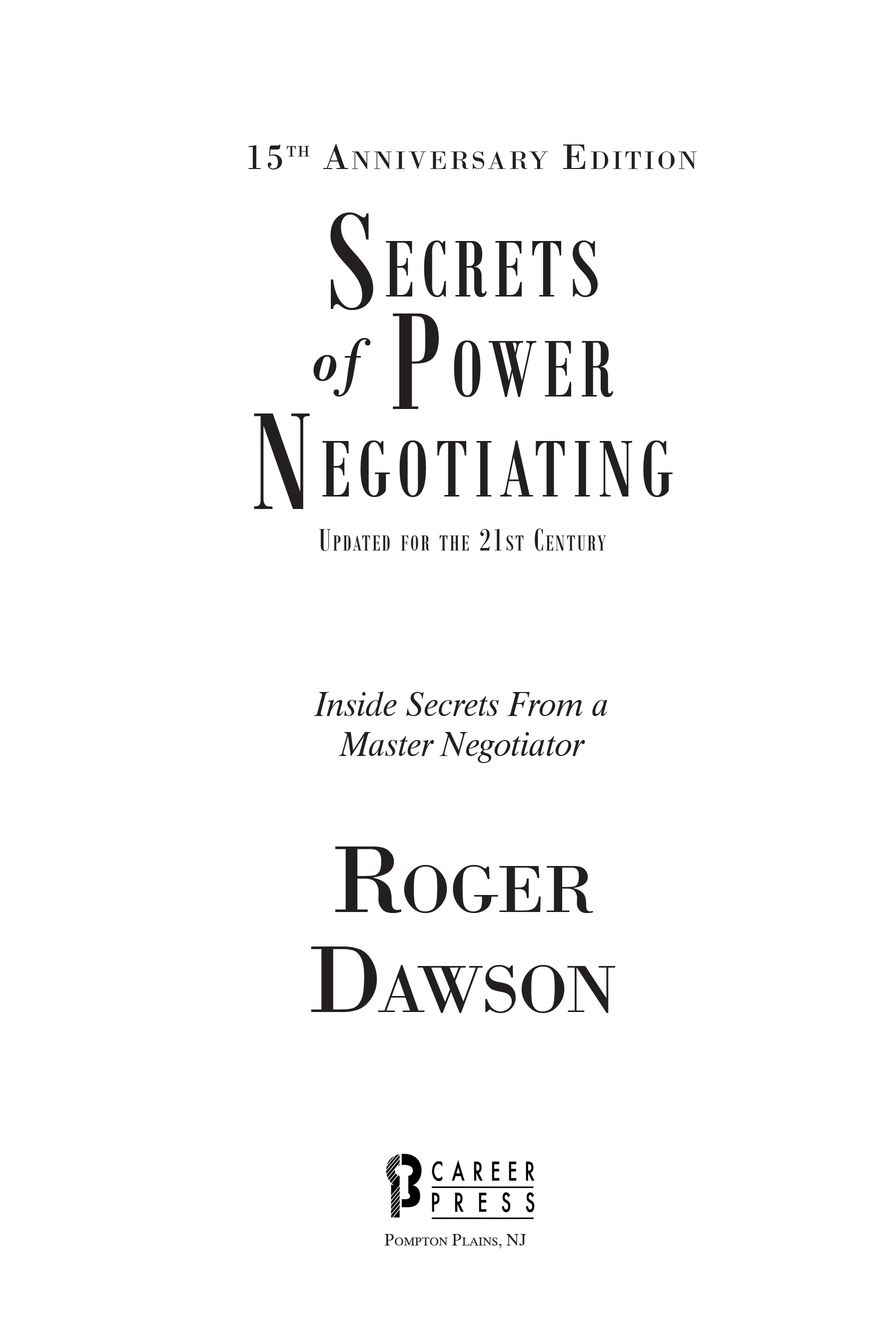
Dedicated to:
My beautiful wife, Gisela, who brought love back into my life.
And to all the attendees of my seminars, readers of my books, and listeners to my audio programs, who shared their negotiating stories with me.
And to my three amazing children: Julia, Dwight, and John.
And to my beautiful grandchildren: Astrid and Thomas.
Introduction
What Is Power Negotiating?
A lot has happened since Career Press published the first edition of this book 15 years ago. A great deal has happened to me, and there has been a great deal of change in the world. The big change that affected us all, of course, was the Internet. It is so much easier to communicate with each other than it used to be. These days, I get up in the morning and answer e-mails that come in from around the world overnight because they work when I sleep. These days, Im just as likely to be teaching Power Negotiating in Shanghai as I am in Seattle.
This third edition very much reflects the brave new world in which we live. Youll find expanded chapters on negotiating with people from other cultures. Its what Ive learned from conducting Power Negotiating seminars around the world, from Kuwait to Nigeria to China, and New Zealand to Iceland. As different as we are, I find that most people want the same thing from a negotiation: They want a fair deal for both sides. They want to use their new negotiating skills to improve their position. They want to be skilled enough to stop the other side from taking advantage of them.
This third edition includes chapters on two subjects that seem to fascinate attendees at my seminars: body language and hidden meanings in Conversation. Remember the high-tech/high-touch theory? It said that the more we contact each other by machine, the more important those rare face-to-face meetings become. The more we are isolated by e-mail and texting of increasingly brief messages, the more we yearn to understand people better.
Youll also find expanded chapters on mediation and arbitration. Thats a big shift in our new world, and a very welcome one. Taking the other party to court is a very expensive and time-consuming way to resolve issues. The trend to replace that with mediation (when people of good faith, guided by a trained mediator, search for a solution acceptable to both sides) makes so much more sense.
In this edition, youll find the new Key Points to Remember invaluable. If you are reading this book on your iPad or Kindle, youll find these points valuable as a last-minute brush up before you go into a negotiation. Search for the phrase Key Points, and go through them on the plane as you fly to your negotiations. If youre reading this as a good old-fashioned book, youll find Key Points to Remember at the end of nearly every chapter.
A lot has changed in the last 15 years, but much has stayed the same. The objective of a negotiation is still to create a win-win solution, which is a creative way that both you and the other person can walk away from the negotiating table feeling that youve won.
Win-win negotiators always talk about the two people who have only one orange, but both want it. They decide that the best they can do is split the orange down the middle, and each settle for half of what they really need. To be sure that its fair, they decide that one will cut and the other will choose.
As they discuss their underlying needs in the negotiation, however, they find that one wants the orange to make juice, and the other needs it for the rind because he wants to bake a cake. They have magically found a way that both of them can win, and neither has to lose.
Oh, sure! That could happen in the real world, but it doesnt happen enough to make the concept meaningful. Lets face it: When youre sitting down in a negotiation, chances are that the other side wants the same thing that you do. Theres not going to be a magical win-win solution. If theyre buying, they want the lowest price and you want the highest price. If theyre selling, they want the highest price and you want the lowest. They want to take money out of your pocket and put it right into theirs.
Power Negotiating takes a different position. It teaches you how to win at the negotiating table, but leave the other person feeling that he or she won. Ill teach you how to do this and do it in such a way that the other side permanently feels that they won. They dont wake up the next morning thinking, Now I know what that person did to me. Wait until I see her again. No! Theyll be thinking what a great time they had negotiating with you and how they cant wait to see you again.
The ability to make others feel that they won is so important that Id almost give you that as a definition of a Power Negotiator. Two people might enter a negotiation in which the circumstances were the same. Perhaps theyre buying or selling real estate or equipment. Both might conclude the negotiation at exactly the same price and terms, but the Power Negotiator leaves the table with the other person feeling that he or she won. The poor negotiator comes away with the other person feeling that he or she lost.
If you learn and apply the secrets of Power Negotiation that Ill teach you in this book, youll never again feel that you lost to the other person. Youll always come away from the negotiating table knowing that you won, and knowing that you have improved your relationship with the other person.
If you have any comments, suggestions, stories to share, complaints to register, or questions to ask, please e-mail the author at Roger@RogerDawson.com.
Section One
Playing the Power Negotiating Game
You play Power Negotiating by a set of rules, just like the game of chess. The big difference between negotiating and chess is that, in negotiating, the other person doesnt have to know the rules. The other person will respond predictably to the moves that you makenot because of metaphysical magic, but because thousands of my students have told me their negotiating experience over the years, and from this feedback we know how the other person will react to any Power Negotiating move you make. Not every time of course, but the likelihood is so high that we now know that negotiating is more of a science than an art.
If you play chess, you know that the strategic moves of the game are called gambits. When I tell you about negotiating gambits, Im talking about a strategic move that involves some risk. Ill teach you how to select the appropriate gambit. Your skill in selecting the right gambit and using it at the right time will minimize the risk. Beginning Gambits get the game started in your direction. Middle Gambits keep the game moving in your direction. You use Ending Gambits when you get ready to checkmate the other person or, in sales parlance, close the sale.
In the first section of this book, Ill teach you the Gambits of Power Negotiating. Youll learn the Beginning Gambits: the things that you do in the early stages of your contact with the other person, to be sure that youre setting the stage for a successful conclusion. As the negotiation progresses, youll find that every advance will depend on the atmosphere that you create in the early stages. You should determine the demands that you make, and the attitude you present with a carefully made plan that encompasses all elements of the negotiation.
Next page
